PAGE 38 – JUNE 2005
Layouts in Containers Return!
In February (Scrapbook Issue #34) we brought you a compendium
of model railways built in various containers. As a result, we received
a lot more information about “contained” layouts from around the world.
Here are some of the best of the crop.
AN AIRPLANE CARRY-ON LAYOUT FROM CANADA
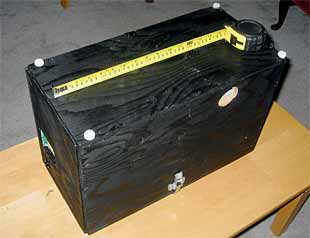
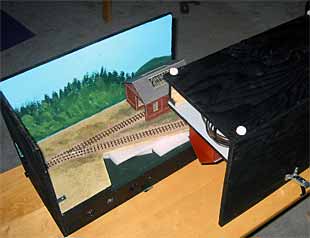
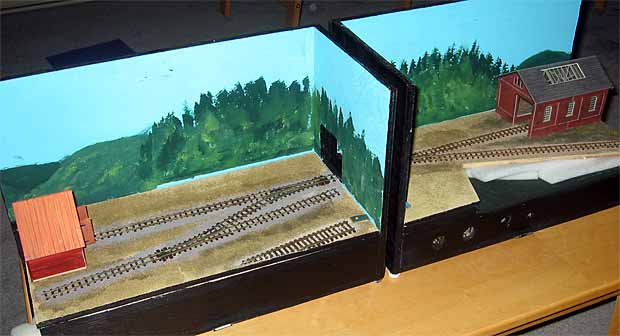
James McMillin, from Saint John, New Brunswick in Canada, built this portable layout to fit under an airplane seat, to be carried aboard as hand baggage. Named Unter den Seaten, the unpacked layout measures 39×9 inches (100×23 cm).
James explains, “My HOn30 layout uses many kits from Barry McClelland of Railway Recollection. The layout represents the two ends of a railway, one end ( the left side) being the interchange with the standard gauge line and the other a port scene served by the shortline railway. The two halves could also be seperated and additional modules placed between them.” The power pack and rolling stock are stored under the layout baseboards and travel inside the container box.
The layout has already traveled by air the width of the continent (to Vancouver) and south as far as Ohio, where it was on display at the recent Midwest Narrow Gauge Show. Stumpy Stone shot the photo below at that meet. Note James’s use of card building kits to save weight — a good stunt for any portable layout.
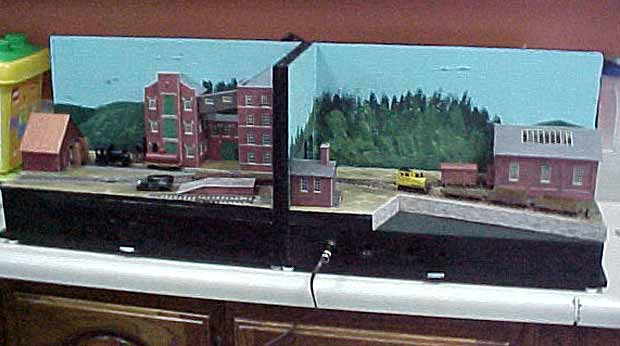
YOU’VE SEEN SHIPS IN BOTTLES, BUT…
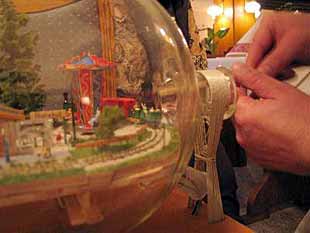
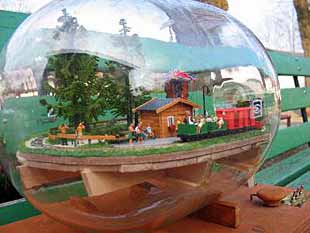
Thanks to Jelle-Jan Postma, from the Netherlands, for sending along these wonderful shots of a Railroad in a Bottle, on display at a German museum. Jelle-Jan provided a web site address for this display, but by the time I got there the material had vanished! If the builder of this very clever model will identify himself or herself, I would like to give proper credit. Meantime, enjoy these views of a fully-scenic “pizza” style model layout — built in a large glass bottle with a very small opening!
A TRANSPORTABLE GARDEN RAILWAY FROM COLORADO
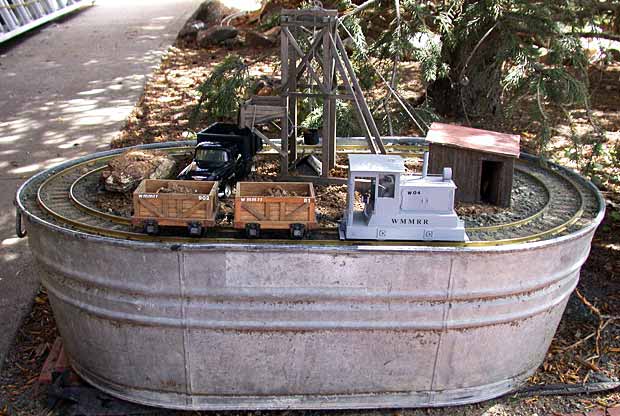
Carl Wagner, from Northglenn, Colorado USA, built this G scale layout in an old washtub that his wife’s grandmother provided. The tub measures 36×21 inches (90×53 cm) inside dimensions. The scale of the model is 1:24.
“The track is regular Aristo Craft 45mm gauge, G scale track,” Carl explains. “I bent the curves on my homemade track bender. The radius of the curves is 8-1/2 in [21.6 cm].
“I scratch built the little critter using an old Lionel four wheel drive mech. I cut the frame apart and shortened it as much as I could so it would make the curves. The wheel base is 2-7/16 in [6.2 cm]. I scratchbuilt the two ore cars also, kind of a generic design. The complete train including the loco and two ore cars measures 18 in [45 cm] from the front pilot to the rear of the coupler. The train runs around the oval just fine but even as small as the cars are they just barely make the curves.
“I scratch built the mine shaft and house copying a little sand mine on Poncha Pass in south central Colorado. My wife and I stopped to see the little mine last summer on our way down to Chama.”
[Ed. Note: After seeing Carl’s work, I find myself staring at every container I see that has rounded ends!]
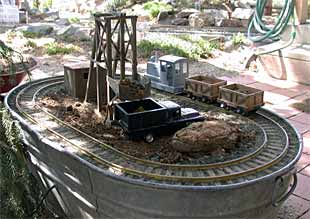
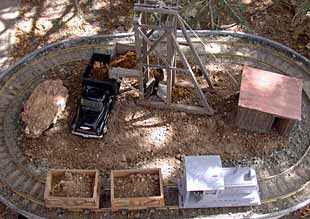
HEXAGONAL FISHTANK LAYOUT FROM GERMANY
From eBay in Germany comes this interesting N-scale layout built in an unusual hexagonal fishtank. Diameter of the track circle is 50 cm (20 in). The town scene is built from Faller building kits, all lit from within, and includes a blue-flashing ambulance model. The original aquarium lighting, contained in the black top, is used to illuminate the layout.
Presumably this interesting display has a new owner by now; if he/she will get in touch with me, we’ll give proper accreditation. Thanks to Alex Lehmann, from Mannheim, Germany, who called this gem to my attention.

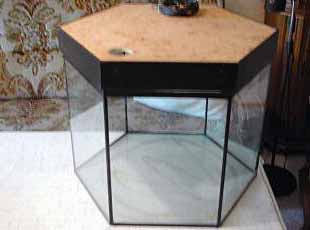
FRENCH QUARRY LAYOUT IN A VIOLIN CASE
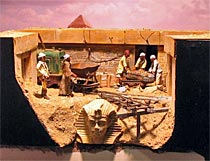
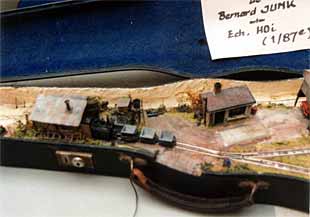 Well-known French modeller Bernard Junk created this charming little industrial line in a violin case. It was photographed by David Thomas, from England, at an exhibition in France in 1988. David points out that this is a true point-to-point industrial line, operating from the quarry (in the neck of the case) to the crushing plant (in the body).
Well-known French modeller Bernard Junk created this charming little industrial line in a violin case. It was photographed by David Thomas, from England, at an exhibition in France in 1988. David points out that this is a true point-to-point industrial line, operating from the quarry (in the neck of the case) to the crushing plant (in the body).
Scale is HOe/HOn30 and, as is true of all of Bernard’s layouts, the scenery is meticulous and skillfully made.
PHOSPHATES IN PHLORIDA (MADE IN OHIO!)
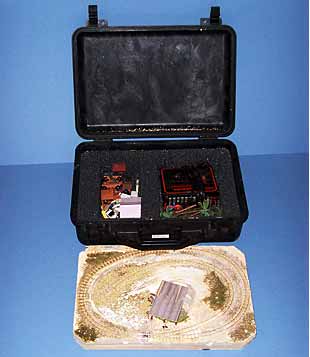
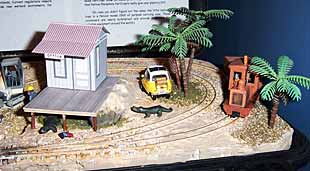
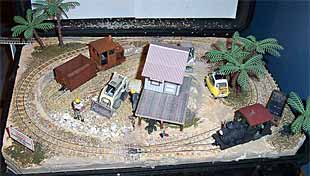
Russ Haigh, from Willoughby, Ohio USA, built this delightful portable phosphate mining line in 1:48 scale. Russ describes the layout this way:
“Size is 11x 17 in (28×43 cm), Scale-O, Gauge-18 in (9 mm); fits into a model 1500 Pelican case. Built with two layers of 5/8 in (16mm) white Styrofoam, Peco HOe track, and scenery items including palm trees and alligators from Pat Catan’s Craft Centers; some Woodland Scenics ground cover, Life-like people and some promo models of Bobcat construction equipment found at a local train show.
“The office is cardstock, the locomotives are a Boulder Valley Models Mighty Midget on a Bachmann Plymouth MDT mechanism and a little scratch-bashed Shay on a Life-Like SW-9. Cars are Grandt Line. All the equipment stores in the case below the layout for transport. An add-on section contains a trestle from a corner of the layout around into a process building containing a two-track fiddle yard.
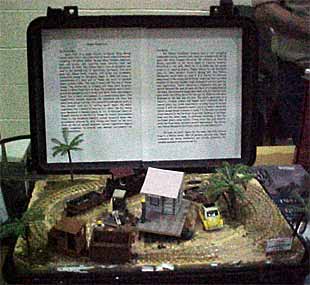 “First appearance was the Midwest Narrow Gauge Show in April 2005.” At that meet, Stumpy Stone took the photo at left. If you look carefully, you can just see the “sneak off” track at the back left, running around on its supporting trestles, to the two-track fiddle yard hidden behind the case cover.
“First appearance was the Midwest Narrow Gauge Show in April 2005.” At that meet, Stumpy Stone took the photo at left. If you look carefully, you can just see the “sneak off” track at the back left, running around on its supporting trestles, to the two-track fiddle yard hidden behind the case cover.
The layout is set in Florida, where huge phosphate mining operations are found. The model includes such delightful touches as Guard ‘Gators, part of the plant Security team; and the company car — a yellow Isetta.
From the Editor’s Scrapbox

By Carl Arendt: This photo shows a portable G-scale Inglenook switching layout that I designed to fit on a standard exhibit-hall table (see plan below). The purpose of this pike was to introduce Inglenook switching — a pleasant and absorbing model railway game — to American rails. Unfortunately, I fell ill just before the train show (in Ohio) where I planned to introduce the layout. So I’m publishing it here, in hopes that those who are interested in switching (shunting) puzzles will find some ideas that are easy and fun to try at home.
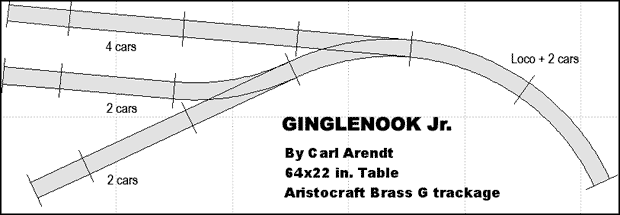
This is actually a reduced-size Inglenook. The full-sized version has track capacities of 5, 3, and 3 cars, with a lead track (head shunt) capacity of a loco plus 3 cars. I’ve also designed and built a full-sized G-scale Inglenook (using the same space-saving, 4-wheeled cars) that fits on a standard 30×72 inch table. You can find full game instructions and lots more interesting information about Inglenooks on Adrian Wymann’s excellent web site.
To American eyes, the Inglenook puzzle plan looks extremely simple. But in fact solving a single puzzle, even on this cut-down version of the game, takes betwen 10 and 20 minutes! And the game strategy — which is very much like the calculations a real switching crew must make out in the field — can become very complicated very quickly.
In a nutshell, the game begins by placing the six colored tokens shown in the photo into a hat — each one representing one of the six cars in the sidings — and drawing out four of them. The object of the game is to assemble those four selected cars into a departing train on the front track (where there already are four cars standing) in as few moves as possible. The catch is that they must be assembled in the order they’re drawn from the hat. Sound simple? It isn’t!
The inventor of the Inglenook game was an Englishman, Alan Wright, who passed away earlier this year at the age of 77. David Thomas, also from the U.K., recently sent me this appreciation of Alan’s work and the puzzle he developed. I want to share it with you, along with my layout design, in honor of a great contributor to our hobby. RIP, Alan.
By David Thomas:
The first published layout in this form and so far as I know the first really portable micro layout was of course Walkeley Sidings before the war, but this was designed to show that H0, and a particular idea for automatic couplings, were feasible. So far as I know, it was never used for more than random shunting.
W. Hardin Osbourne also came up with a similar shunting puzzle layout as a Christmas game. This version subtracted points for bashing stock too hard, derailments, etc., but it didn’t define the puzzle beyond that. Although he offered a portable plan built on two boards, I suspect that he only laid it out on the dining room table with sectional track to amuse his children or grandchildren at Christmas (and nothing wrong with that — sounds a lot more fun than Monopoly).
What I think Alan contributed was the idea of applying a very well defined set of rules to a very simple but very attractive layout that looked like something you might easily have met on the prototype — but with the idea of random selection giving a real bite to it. I know that John Allen’s Timesaver came earlier but it is a lot more complex to build, and I think he intended it more as something for fairly experienced modellers to build and take to meetings than as a first exercise for beginners.
With Inglenook on the other hand I can’t say how many people I’ve met at exhibitions who’ve said they’ve no room nor time to even begin modelling … until they realise just what can be done with two points [turnouts], a yard or so of the track they’ve already got kicking about, a 4 x 1 plank (alright 5 x 1 in North America) , eight wagons and a shunting loco that they’ve also already got, one electrical feed and about an hour or two on a wet Sunday afternoon and absolutely no previous modelling experience.
When explained like this I’ve really seen the bulb light up more than a few times.
Leave a Reply